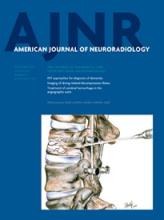Research ArticlePatient Safety
Open Access
Whole-Brain Adaptive 70-kVp Perfusion Imaging with Variable and Extended Sampling Improves Quality and Consistency While Reducing Dose
I. Corcuera-Solano, A.M. McLellan, A.H. Doshi, P.S. Pawha and L.N. Tanenbaum
American Journal of Neuroradiology November 2014, 35 (11) 2045-2051; DOI: https://doi.org/10.3174/ajnr.A4043
I. Corcuera-Solano
aFrom the Department of Neuroradiology, Mount Sinai Medical Center, One Gustave L. Levy Place, New York, New York.
A.M. McLellan
aFrom the Department of Neuroradiology, Mount Sinai Medical Center, One Gustave L. Levy Place, New York, New York.
A.H. Doshi
aFrom the Department of Neuroradiology, Mount Sinai Medical Center, One Gustave L. Levy Place, New York, New York.
P.S. Pawha
aFrom the Department of Neuroradiology, Mount Sinai Medical Center, One Gustave L. Levy Place, New York, New York.
L.N. Tanenbaum
aFrom the Department of Neuroradiology, Mount Sinai Medical Center, One Gustave L. Levy Place, New York, New York.

References
- 1.↵
- 2.↵
- Imanishi Y,
- Fukui A,
- Niimi H, et al
- 3.↵
- Wintermark M,
- Maeder P,
- Verdun FR, et al
- 4.↵
- Wintermark M,
- Smith WS,
- Ko NU, et al
- 5.↵
- 6.↵
- Abels B,
- Klotz E,
- Tomandl BF, et al
- 7.↵
- Hirata M,
- Sugawara Y,
- Murase K, et al
- 8.↵
- Bogartz G,
- Golding SJ,
- Jurik AG, et al
- 9.↵
- Siegel S,
- Castellan JN
- 10.↵
- Hirata M,
- Sugawara Y,
- Fukutomi Y, et al
- 11.↵
- Cohnen M,
- Fischer H,
- Hamacher J, et al
- 12.↵
- Huda W,
- Lieberman KA,
- Chang J, et al
- 13.↵
- Wintermark M,
- Lev MH
- 14.↵
- 15.↵
- 16.↵
- 17.↵
- Konstas AA,
- Goldmakher GV,
- Lee TY, et al
- 18.↵
- Fieselmann A,
- Kowarschik M,
- Ganguly A, et al
- 19.↵
- 20.↵
- Diekmann S,
- Siebert E,
- Juran R, et al
- 21.↵
- Wintermark M,
- Maeder P,
- Thiran JP, et al
In this issue
American Journal of Neuroradiology
Vol. 35, Issue 11
1 Nov 2014
Advertisement
I. Corcuera-Solano, A.M. McLellan, A.H. Doshi, P.S. Pawha, L.N. Tanenbaum
Whole-Brain Adaptive 70-kVp Perfusion Imaging with Variable and Extended Sampling Improves Quality and Consistency While Reducing Dose
American Journal of Neuroradiology Nov 2014, 35 (11) 2045-2051; DOI: 10.3174/ajnr.A4043
0 Responses
Jump to section
Related Articles
- No related articles found.
Cited By...
This article has not yet been cited by articles in journals that are participating in Crossref Cited-by Linking.
More in this TOC Section
Similar Articles
Advertisement











